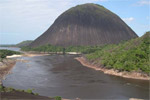The turkey-sized, noisy, fruit-feasting guans are arguably one of the strangest wildlife sightings in the tropical forests of Central and South America. Ancient animals, these birds are members of the Cracidae family—which also include equally-odd currasows and chachalacas—and are actually distantly related to megapode, or mound-building, birds of Australiasia. A new study in mongabay.com’s open-access journal Tropical Conservation Science looks at a particularly endangered guan: the Cauca gaun (Penelope perspicax).
Found only in Colombia’s Cauca Valley—for which it is named—the Cauca guan has lost around 95 percent of its habitat and today survives only in a few forest patches. With a total estimated population of less than 1,000 mature individuals, it’s no surprise then that the IUCN Red List categorizes the species as Endangered. To determine how the Cauca guan is faring, a team of scientists led by Gustavo H. Kattan, counted guans across three forests.
“There is very little documentation of actual densities for tropical birds in general and endangered species in particular,” Kattan and his colleagues write in the paper.
 The rare Cauca guan. Photo by Pete Morris/Birdquest. |
The researchers found that the Cauca guan inhabits both primary and secondary forests with around 10-18 guans per square kilometer in two of the sites. However, a secondary forest in Bremen sported a remarkably high density: over 42 birds per square kilometer. The scientists write that this density is comparable to densities of small passerines or songbirds.
“Secondary forest offers abundant fruit resources that are commonly eaten by guans, which may explain the high density observed in this habitat type in Bremen. Cauca Guans also use vegetation strips along streams,” the authors write, adding that “this opens the possibility of using corridors to connect populations currently isolated in forest patches, but to implement this strategy other factors such as increased vulnerability to hunting have to be taken into account.”
Many species of guan are gravely imperiled by overhunting as the birds are large and often roost for long intervals, making them easy targets.
Despite the high densities uncovered at Bremen Nature Reserve, the scientists say the species is still gravely threatened.
“Although the Cauca Guan is not a habitat specialist and may reach high densities under some conditions, globally this guan remains rare and efforts for its conservation should be sustained.”
Citations:
- Kattan, G. H., Roncancio, N., Banguera, Y., Kessler-Rios, M., Londoño, G. A. Marín, O. H. and Muñoz, M. C.2014. Spatial variation in population density of an endemic and endangered bird, the Cauca Guan (Penelope perspicax).
Tropical Conservation Science Vol.7 (1): 161-170.
Related articles
Next big idea in forest conservation? Connecting forest fragments

(01/31/2014) Dr. Stuart Pimm is an expert in extinctions: why they happen, how fast they happen, and how they can be prevented. Reconnecting forest fragments and avoiding fragmentation, according to Pimm, are among the most crucial things we can do to conserve global biodiversity. His organization SavingSpecies identifies areas at-risk for extinctions and helps local organizations fundraise so they can protect and restore habitats and safeguard biodiversity.
Colombia to protect remote region bordering Venezeula

(01/13/2014) The Colombian government plans to declare a remote area bordering Venezuela a new protected area. Colombian Minister of Environment, Luz Helena Sarmiento, told the El Espectador that President Juan Manuel Santos will declare the Estrella Fluvial de Inirida river area a Ramsar Wetland of International Importance. The designation would give Colombia six Ramsar sites.
Scientists identify 137 protected areas most important for preserving biodiversity

(11/14/2013) Want to save the world’s biodiversity from mass extinction? Then make certain to safeguard the 74 sites identified today in a new study in Science. Evaluating 173,000 terrestrial protected areas, scientists pulled out the most important ones for global biodiversity based on the number of threatened mammals, birds, and amphibians found in the parks. In all they identified 137 protected areas (spread over 74 sites as many protected areas were in the same region) in 34 countries as ‘irreplaceable.’
Adorable baby olinguito photographed in Colombia (picture)
(11/01/2013) Researchers returning from an expedition to a cloud forest in Colombia have released photos of the world’s most recently-discovered carnivore, the olinguito.














